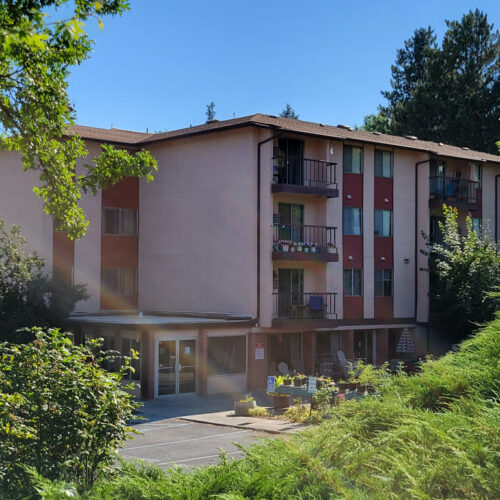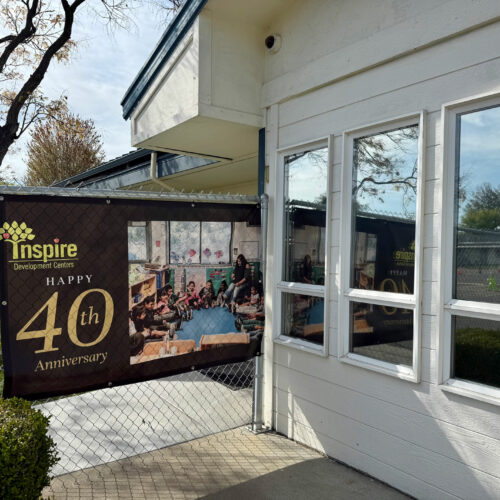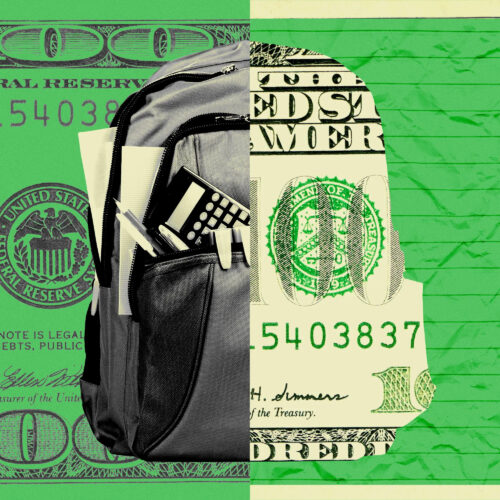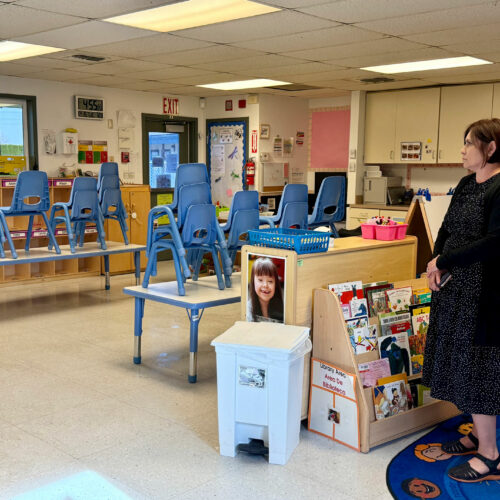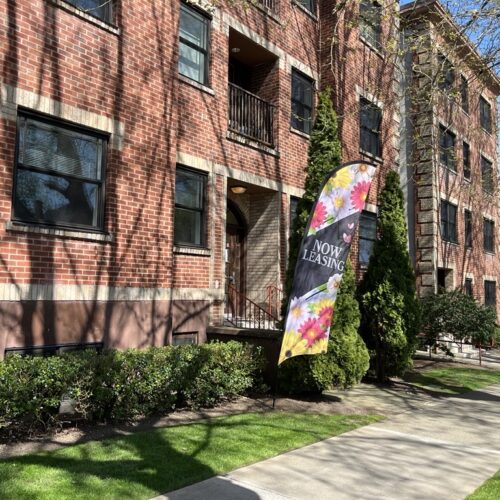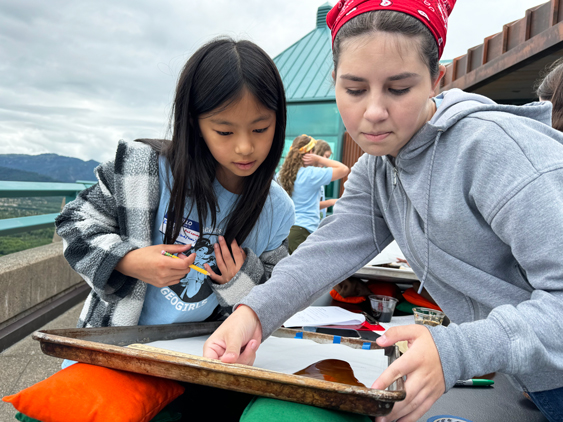
On Mount St. Helens, students dig into potential geology careers
Watch
Listen
(Runtime 4:14)
Read
In the shadow of Mount St. Helens’ summit, 20 girls spent a week studying pumice, ash and lava at a GeoGirls camp. The famous Washington volcano served as a base camp for middle and high school girls to dig into the vast field of geology.
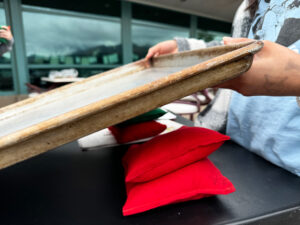
Girls balance cookie sheets with bean bags to get a 20 degree slope. (Credit: Courtney Flatt / NWPB)
On a cloudy Thursday, some of the girls learned about viscosity — how fast “magma” flows downhill.
To do that, they had plastic cups full of dark brown corn syrup. They poured different mixtures of it down a cookie sheet to see how fast it moved, giggling as they blew bubbles in the sticky stuff to see how much resistance the corn syrup had.
“Magma flowing down, the viscosity, would be really helpful to scientists to learn about how much time we have and how quickly we can evacuate everyone,” said Elise Cha, an eighth grader from Camas, Washington.
It’s an important lesson the girls have learned on this mountain, which erupted in 1980, killing 57 people.
“We were kind of careless back in 1980, and we didn’t evacuate quickly enough,” Cha said.
The U.S. Geological Survey puts on the weeklong camp in conjunction with the Mount St. Helens Institute. As part of the camp, the students hiked to places on the mountain to see large mounds called hummocks.
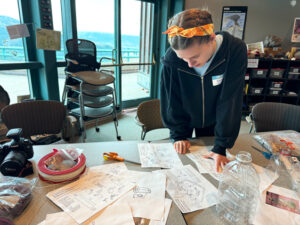
Anna Kappler, a junior from Portland, studies the worksheets for a photogrammetry experiment. (Credit: Courtney Flatt / NWPB)
“When Mount St. Helens exploded, some of the pieces of the mountain stayed together and they rolled away. They’re basically big mounds that you see, and it’s just a piece of the mountain sitting there,” said Anna Kappler, a junior from Portland.
The girls also learned about the modern technologies geologists use to monitor volcanoes.
With an all-female staff, from cooks to cartographers, it’s all about inspiring and empowering these students, said Liz Westby, a spokesperson and geologist with the U.S. Geological Survey. This is the eighth GeoGirls camp.
“We want them to feel comfortable, that they can achieve those roles, that it’s not just some roles that they might feel like that’s all that’s available to them, that no, that actually it’s much broader. The world is much bigger than that,” Westby said.
At camp, Westby said, the girls became field scientists, with the high school students acting as mentors for the younger campers. They worked on projects to design and engineer equipment. Take a purple, 6-foot wide helium balloon. As a joke, the girls named it Barney.
“It’s called Barney because it’s purple,” said Adria Garcia, a freshman from Richland, Washington.
The students MacGyvered a way to attach a digital camera to the balloon, using rubber bands, a spare carabiner and the top half of a plastic juice jug.
The camera will constantly shoot photos as the girls walk around a trail, guiding the balloon on a long string, Garcia said.
“It’s to show the landscape to see if maybe the landscape has changed or the volcano, maybe if it’s grown a couple inches just for monitoring,” she said.
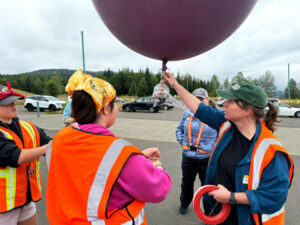
Instructor Angie Dieffenbach holds onto a large ballon and tells the girls how to safely hold it as they walk around. (Credit: Courtney Flatt / NWPB)
The technique is called photogrammetry, something U.S. Geological Survey geologist Angie Dieffenbach specializes in. Dieffenbach can tell when a lava dome is building up fast and what hazards that might create. Right now, at Mount St. Helens, she’s using the technique to monitor glaciers.
Dieffenbach said this sort of camp would have really helped her as a student.
“I love that they’re always so curious. And they’re really good at troubleshooting. I always say, being creative is a huge part of science. That’s often kind of overlooked, right?” she said.
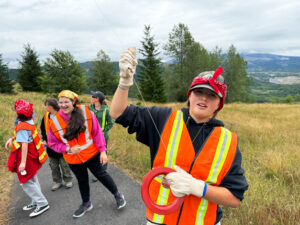
Akemi Sheibley, a freshman from Seattle, walks around a hike while holding a large balloon. Other girls in her group watch to make sure the balloon doesn’t get snagged on anything. (Credit: Courtney Flatt / NWPB)
After the girls attached the camera, and the professionals blew up the balloon with helium, they floated the balloon over trees and made their way around obstacles. Akemi Sheibley, a freshman from Seattle, carried the balloon part way around the hike. She said she felt like she gained confidence during this camp.
While carrying the balloon, Sheibley said her arms got a little tired, and she could feel the tension on the rope when the wind blew.
“It’s like walking a dog except for the dog’s in the sky, and it’s a little bit more fragile than an actual dog. It’s Barney, Barney the purple balloon dog,” she joked.
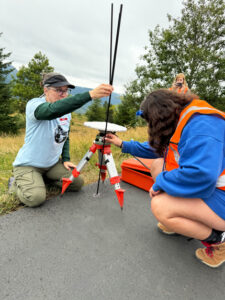
High school junior Paige Molyneux learns about GPS systems at the GeoGirls camp. (Credit: Courtney Flatt / NWPB)
For high school junior Paige Molyneux, who’s from Longview, Washington, this camp has been more than a fun week away from home. This was Molyneux’s second time returning to the camp.
“The first time I was here, that’s when I knew I was like, ‘I want to be doing the stuff that they’re doing.’ Some people are just talking about it. Some people are outside working with it. Other people are behind the computer,” Molyneux said.
After college, Molyneux said, their plan is to be outside, collecting rock samples. Enjoying nature.


